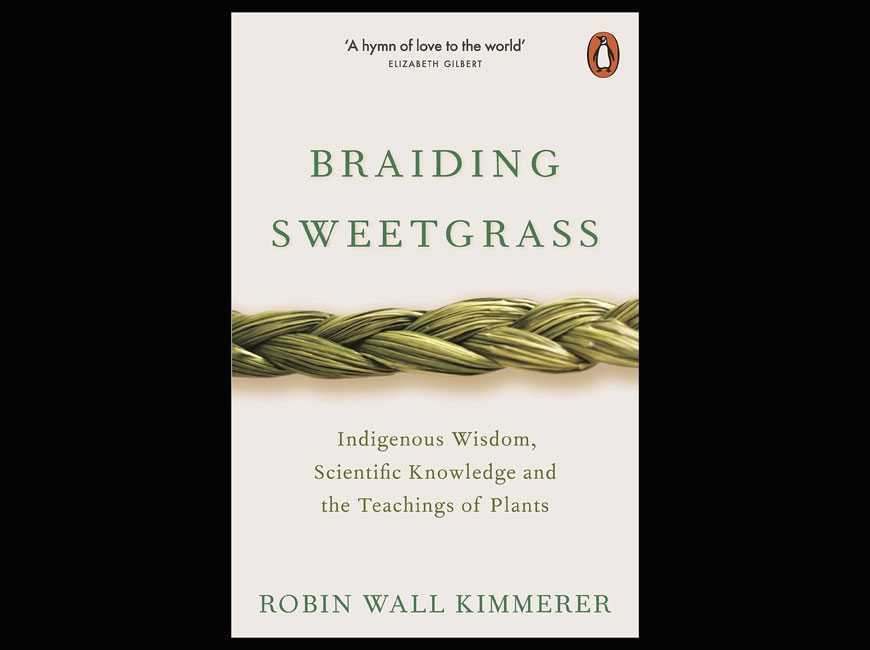As one of the wisdom-keepers of the Native American Potawatomi Nation, there is a reason why Robin Wall Kimmerer is also a best-selling author. Her knowledge, widsom and message in her book Braiding Sweetgrass (Milkweed Editions, 2013, 390 pages) is purposeful and prescient for our times. And it resonates in the human community’s subconscious as truth.
She speaks with authority, courage and compassion, both on the page and off (go to YouTube) as someone who you might like to see in a position of national leadership. But the wise ones know better than to take on the mantle of politics and ego-driven power. In a time when women are rising to the forefront in our culture, Robin Wall Kimmerer has emerged as one of those women. In Braiding Sweetgrass, she tackles one of the most important issues of our time — how we relate to place. Place meaning nature and the earth and how we are ignoring and even ruining the very foundations for our survival. In Braiding Sweetgrass, we inherit her wisdom and knowledge as described in the subtitle for the book: “Indigenous Wisdom, Scientific Knowledge, and the Teachings of Plants” through the mythic history and stories of the Anishinabekwe culture handed down over thousands of years, going back to the original instructions given to our most ancient ancestors on how to navigate our lives on this planet.
In Kimmerer’s preface, she elucidates the context of the book’s title and contents:
“This [sweetgrass] braid is woven from three strands: indigenous ways of knowing, scientific knowledge, and the story of an Ahishinabekwe scientist trying to bring them together in service to what matters most. It is an intertwining of science, spirit, and story — old stories and new ones that can be medicine for our broken relationship with earth, a pharmacopoeia of healing stories that allow us to imagine a different relationship, in which people and land are good medicine for each other.”
From here and for 390 pages we get what amounts to nothing less than a biblical lesson in indigenous history and spiritual ecology. In her story about Nanabozho — the first human — she talks about the subject (and the current issue) of immigration. “Nanabozho did not know his parentage or his origins — only that he was set down into a fully peopled world of plants and animals, winds, and water. He was an immigrant too. Before he arrived, the world was all here, in balance and harmony, each one fulfilling their purpose in the Creation. He understood, as some did not, that this was not the ‘New World,’ but one that was ancient before he came. His role was not to control or change the world as a human, but to learn from the world how to be human and that the land is the real teacher.”
Related Items
From there, the lesson continues as Kimmerer speaks of human isolation and “species loneliness” due to our inattention and lack of specific and scientific knowledge of the plant and animal life that surrounds us. “If he could combine the lessons from nature with the strength of his own good mind, he could discover new things that would be useful for the people to come,” she writes, emphasizing that the lessons Nanabozho learned are the mythic roots of Native science, medicine, architecture, agriculture, and ecological knowledge. “By honoring the knowledge in the land, and caring for its keepers, we start to become indigenous to place,” she writes, honing in on the over-riding theme in her book and what I have termed in my own work many years ago as becoming “new natives.” About the sweetgrass, she says “Sweetgrass in a long braid, offers protection to a traveler. A path scented with sweetgrass leads to a landscape of forgiveness and healing for all who need it.” Then she goes on to speak prophetically of human weaknesses and the situation we find ourselves in today. “Nanabozho found that the arrogance of power could be used to unleash unlimited growth — an unrestrained, cancerous sort of creation that would lead to destruction. He vowed to walk with humility in order to try to balance his arrogance. That too is the task of those who would walk in his footsteps.”
Kimmerer then goes on to reflect:
“I sit a long time and eventually the sound of the wind in Grandmother Sitka Spruce branches washes words away and I lose myself in just listening — to the crisp voice of laurels, the chatter of alders, the whispers of lichens ... and have been reminded that plants are our oldest teachers.”
Finally, at the end of the story of Nanabozho and as a fitting denoument to this review, she writes: “Being naturalized to place means to live as if this is the land that feeds you, as if these are the streams from which you drink, that build your body and fill your spirit. To become naturalized is to know that your ancestors lie in this ground. Here you will give your gifts and meet your responsibilities. To become naturalized is to live as if your children’s future matters, to take care of the land as if our lives and the lives of all our relatives depend on it. Because they do.”
Thomas Crowe is a regular contributer to The Smoky Mountain News and author of the award-winning non-fiction memoir Zoro’s Field: My Life in the Appalachian Woods. He lives in Tuckasegee in Jackson County and can be reached at This email address is being protected from spambots. You need JavaScript enabled to view it.




